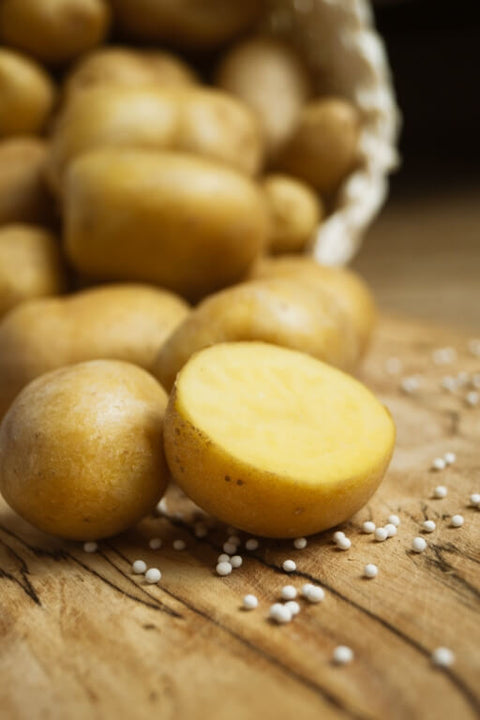
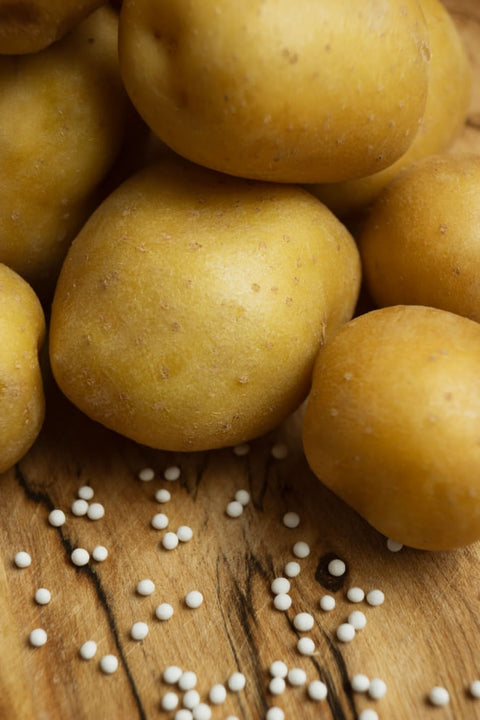
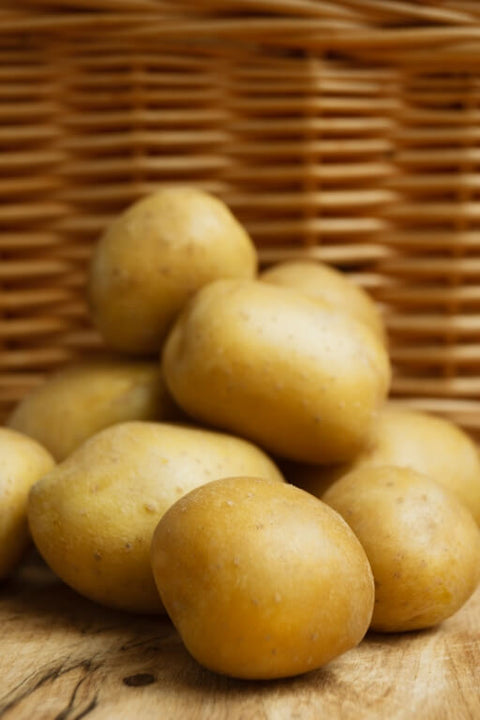
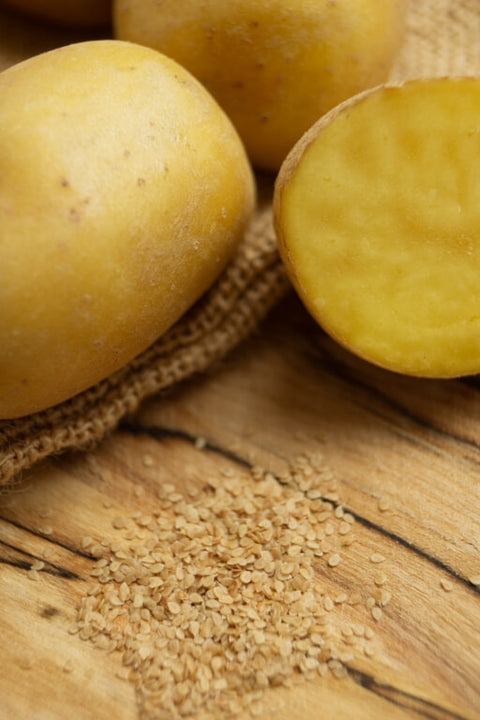
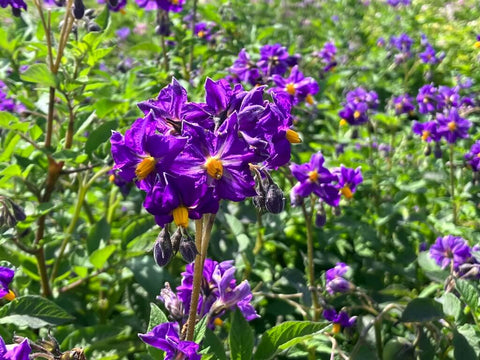

HORTINOVA Inc.
SUNBITE F1 - Baby Potato (True Seed)
Solanum tuberosum
A breakthrough in modern plant breeding!
Sunbite F1 is a hybrid potato grown from true potato seed (TPS) – lightweight, disease-free, non-GMO, and easy to store.
- Produces an abundance of golden baby potatoes in just 100–120 days
- Round to oval mini tubers with smooth skin and creamy yellow flesh
- Delicious firm texture – perfect for boiling, baking, or fresh salads
- Strong resistance to late blight and tolerance to other common diseases
- Thrives with minimal sprays, giving high, reliable yields naturally
- Produces beautiful purple flowers that brighten any garden
- Suitable for both organic and conventional gardens
Sunbite F1 is the ideal choice for home gardeners who want a healthy, productive crop and a steady supply of tasty, homegrown potatoes.
START:
Start indoors 6–8 weeks before your last frost (typical March–May in temperate regions).
TRANSPLANT:
Plan to transplant 4–6 weeks after sowing so seedlings don’t begin forming mini-tubers in pots.
CONTAINERS & MIX:
Use plug trays or 5–7 cm / 2–3″ pots filled with a fine, sterile seed-starting mix (pH 5.5–6.8). One seed per cell, 6 mm (¼″) deep.
GERMINATION CONDITIONS:
16–20 °C (60–68 °F), bright light (12–16 h/day). Keep the mix evenly moist, not wet. Germination usually takes 10–14 days.
AFTER SPROUTING:
Keep bright and slightly cooler (15–18 °C). Begin a gentle liquid feed once true leaves appear (see FEED). Pot up once if roots fill the cell.
HARDEN OFF:
7–10 days outdoors in dappled light and low wind before planting out.
THIN:
If more than one seed sprouts per cell, snip extras at soil level and keep the strongest seedling.
PLANT OUT:
- Timing & size: Transplant 4–6 weeks from sowing, when plants are sturdy and ~5–10 cm (2–4″) tall.
- Plant after hard-frost risk, in soil ≥8–10 °C (46–50 °F).
- Soil: Loose, fertile, well-drained loam; pH 5.5–6.5. Work in mature compost before planting. Avoid fresh manure.
- Method: Plant in a shallow trench or on a low ridge. Bury stems so only the top leaf whorl (1″/2–3 cm) is above soil.
SPACING:
- For smaller “new” potatoes: 25 cm (8″) between plants in any direction.
- For larger tubers: 35 cm (12″) in-row, 60–75 cm (24–30″) between rows.
- Containers: One plant per 15–20 L (4–5 gal) pot or grow bag.
- Hilling: When plants reach 10–15 cm (4–6″), hill soil or mulch up the stems, covering the lower ⅔. Repeat every 1–2 weeks until a 15–25 cm (6–10″) ridge forms. This prevents greening and boosts yield.
EXPOSURE:
- Full sun (6–8+ hours/day).
- In hot climates, light afternoon shade helps during heat spells.
TEMPERATURE:
- Best growth 15–21 °C (59–70 °F); tuber set is strongest in cool soils.
- Growth slows above 29 °C (85 °F).
- Protect from late frosts with row cover.
SUPPORT:
- No staking required.
- Use low hoops/row cover only for frost or beetle exclusion.
PRUNING:
- No routine pruning.
- You may remove flowers/green berries to push energy to tubers.
- DO NOT EAT BERRIES (TOXIC).
WATER:
- Water in well at transplant. Keep the root zone consistently moist—about 2.5 cm (1″) per week, more on sandy soils and during tuber bulking (from first bloom onward). Avoid waterlogging.
- Mulch (straw/leaves) to stabilize moisture and soil temperature. Reduce heavy watering once vines begin to yellow to help skins set.
FEED:
- TPS behaves like potatoes for nutrition: steady, moderate fertility with emphasis on potassium.
- At planting: Mix in 5-10-10 (or similar) at 60–90 g/m² (2–3 oz/10 ft²) or equivalent organic blend; or charge containers with a balanced slow-release fertilizer per label.
- During hilling: Side-dress with 20–30 g/m² of 5-10-10 (or fish/seaweed feed) once or twice.
- Liquid feed for seedlings/containers: ¼–½-strength all-purpose fertilizer weekly.
- Avoid excess N after flowering—it drives foliage at the expense of tubers.
PROTECT:
- Clean start: TPS doesn’t carry the tuber-borne diseases that often hitchhike on seed potatoes. Still rotate beds every 3–4 years away from other solanums.
- Pests: Hand-pick Colorado potato beetles; use row cover early. Control aphids/leafhoppers to limit virus spread. Keep foliage dry in evenings.
- Diseases: Space for airflow; water at soil level. Manage late blight by removing infected foliage promptly; don’t compost diseased vines.
- Physiological issues: Prevent greening by diligent hilling/mulching. To reduce common scab, keep soil slightly acidic and avoid drought during early tuber set.
- Baby potatoes: Begin 6–8 weeks after transplanting (often around first bloom) when tubers are egg-sized. Gently reach into the hill and take a few without uprooting the plant.
- Main/storage crop: Harvest when vines yellow and die back. For best skin set, cut tops and wait 7–10 days, then dig in dry weather.
- Curing & storage: Brush off soil (don’t wash). Cure in the dark at 10–15 °C (50–59 °F) with high humidity for 7–10 days. Store in the dark, ventilated, 4–7 °C (39–45 °F). Keep away from apples and ethylene sources.
Let customers speak for us
from 23 reviewsWe grow several varieties of various colours of tomatoes, and the contrast of these tomatoes with other colours is fantastic. We've had a very long season with our plants, excellent disease resistance, great flavour.

This review applies to all of the seeds I purchased from Hortinova - beautiful tomatoes, good disease resistance and excellent production. Our field season extended to 10 weeks. We've had comments of excellent flavour from our customers as well, highly recommend any Hortinova seed.

This tomato is good taste tomato. Small red round tomato. Bigger then cherry tomatoes but smaller then regular one. I like it. Perfect for salads and fresh eating. Ordered seeds for next season.

2nd time ordering. Very satisfied with qualify and result. Thank you

BALCONY YELLOW F1 - Hybrid Cherry Tomato Seeds

Delivered very fast, packed very good, in professional condition and quality. Thanks

DUETT - Open Pollinated Radish Seeds

We will see what they are like this summer.

Type crimson de bonne grosseur avec une superbe uniformité et très hâtif. Un des premiers prêt en saison. Semences très petites et peu nombreuses. Goût très sucré et chaire croquante. Chair passant du rose au rouge en cours de saison. Les plants sont forts et très vigoureux avec des grosses feuilles.

Vigueur des plants impressionante avec des fruits résistants aux fissures et aux dommages. Très bonne conservartion et goût très sucré lorsque les nervures deviennent orange. Peu être récolté lorsque les nervures sont vertes également. Cavité des semences très compacte et petite laissant beaucoup de chair.

Melon qui fond en boûche avec un goût se rapprochant du melon miel et du cantaloup à la fois, très sucré. Faire attention aux irriguations lorsque le melon devient mature car il peut fendre au champs. Très odorant.

Avec son apparence côtellée, son très gros calibre et ça couleur rose, cette tomate se démarque des autres sur les tablettes. Variété plus résistante à la pourriture apicale que la plus part des autres tomates roses. Bon ensemble de résitance aux maladies également.

Tomate noire dont les faces qui ne sont pas exposé au soleil passent du vert au rouge lorsque mature donnant un aspect unique aux fruits. Charactéristiques similaires à la Barrio avec un goût superbe sans acide. Les clients l'on adoré.

Superbe adaptabilité et excellente résistance aux maladies. Fruits uniformes qui ne fendent pas, bonne conservation. Ajoutez à cela un goût unique avec une légère acidité et une pointe sucré.















